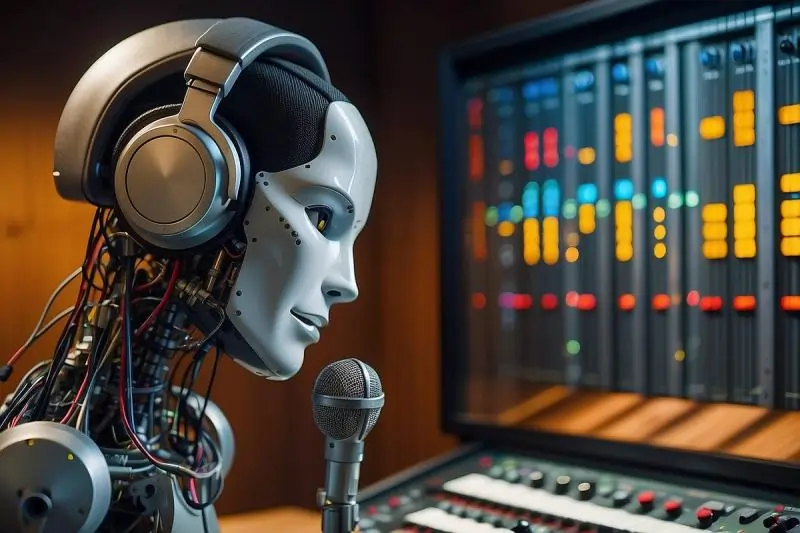AI voice cloning is rapidly evolving, and its implications for broadcasting are vast. But what exactly is AI voice cloning, and why is it so crucial for the future of media? This article dives deep into the rise of AI voice cloning technology, exploring how it works, its applications in broadcasting, and the ethical dilemmas that come with it.
The Rise of AI Voice Cloning Technology:
What is AI Voice Cloning?
AI voice cloning is the process of using artificial intelligence to replicate a human voice. By analyzing recordings, AI can create a digital model that mimics the tone, pitch, and nuances of a person’s voice. The technology has advanced to the point where cloned voices can be nearly indistinguishable from the original.
How Does AI Voice Cloning Work?
AI voice cloning relies on deep learning algorithms that process vast amounts of voice data. These algorithms learn the patterns in speech, enabling the creation of a synthetic voice that can speak new sentences in a way that sounds natural. Neural networks play a significant role in this process, simulating the way the human brain processes sound.
Historical Background of Voice Synthesis:
Early Attempts at Voice Cloning
Voice synthesis isn’t new. The first attempts at replicating human speech date back to the 18th century with mechanical devices. However, these early efforts were rudimentary and lacked the natural flow of human speech.
Evolution of AI in Voice Technology
The advent of AI brought a revolution in voice synthesis. In the 21st century, machine learning and neural networks enabled the development of more sophisticated voice cloning techniques, making the technology more accessible and realistic.
The Mechanics of AI Voice Cloning:
Understanding the Technology Behind Voice Cloning
At its core, AI voice cloning uses a combination of machine learning and deep learning. Machine learning algorithms analyze and learn from large datasets of voice recordings. Deep learning, particularly through the use of neural networks, helps in refining the cloned voice, making it sound more human-like.
Accuracy and Authenticity in AI-Generated Voices
Creating an authentic-sounding cloned voice is challenging. The AI must capture the subtle emotions and intonations in human speech. Researchers are continually refining algorithms to improve the emotional depth and accuracy of AI-generated voices.
Applications of AI Voice Cloning in Broadcasting:
AI Voice Cloning in Radio Broadcasting
Radio broadcasters are leveraging AI voice cloning to personalize the listener experience. Imagine a radio host who knows your preferences and adjusts the content accordingly. AI can also automate tasks like news and weather updates, making radio more efficient and tailored to individual listeners.
Impact on Television and Film
In television and film, AI voice cloning is opening up new possibilities. Dubbing and voiceovers can be done with greater precision, maintaining the original actor’s voice even in different languages. Additionally, the voices of deceased celebrities can be preserved and used in new productions, allowing for posthumous performances.
AI Voice Cloning in Podcasts and Digital Media
Podcasters are exploring AI voice cloning to enhance content creation. Virtual hosts can be created, enabling podcasters to produce more content without the need for additional voice talent. This technology also allows for greater flexibility in content delivery, catering to diverse audiences.
Ethical Considerations and Challenges:
The Ethical Dilemma of Voice Cloning
With great power comes great responsibility. AI voice cloning raises significant ethical questions. Who owns the rights to a cloned voice? Is it ethical to use someone’s voice without their consent? These are pressing issues that need to be addressed as the technology becomes more widespread.
Addressing Privacy Concerns
Privacy is another major concern. AI voice cloning relies on personal voice data, raising questions about how this data is stored and used. Legal frameworks and regulations must evolve to protect individuals from potential misuse of their voice data.
The Future of AI Voice Cloning in Broadcasting:
Innovations and Advancements on the Horizon
The future of AI voice cloning is bright, with continuous innovations on the horizon. One area of growth is the integration of AI-powered assistants, making interactions more natural and personalized. Additionally, AI voice cloning can enhance accessibility, providing a voice for those who cannot speak.
Potential Impact on Employment in Broadcasting
While AI voice cloning presents exciting opportunities, it also poses challenges for traditional broadcasting roles. Voice actors may find their jobs shifting as AI takes on more of their work. However, new careers may emerge, focusing on managing and refining AI-generated content.
Predictions for the Next Decade
Looking ahead, AI voice cloning is poised to become a staple in broadcasting. As technology continues to improve, it will likely shape the way we consume media, making it more interactive and personalized.
Conclusion
AI voice cloning is not just a technological advancement; it’s a game-changer for the broadcasting industry. From radio to television to digital media, the applications are vast and varied. However, as with any powerful tool, it must be used responsibly. The future of broadcasting will undoubtedly be shaped by AI voice cloning, and the industry must navigate the ethical and practical challenges that come with it.
